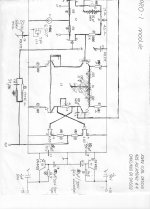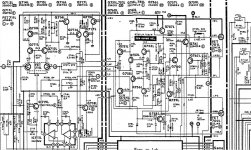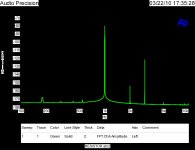My point exactly John ( speculating , we all do it at some point ) . However to be able to say amps can work with global feedback is important . Even if only one amp . One is a enough . I have listen to many amps that do not have global feedback . Mostly they work very well . All I would say is that global feedback as far as I can tell is not a reason for an amp to sound bad . Maybe what I have just said is obvious , sometimes the obvious needs stating to refresh the memory of it . Good amps often sound very good either way . Now , threes a thought !
I am always amazed at how reliable aircraft are , I am a very uncomfortable passenger as I have a deep understanding of the machine I am in . I am glad I am not in aircraft design as they would still be Spitfires at best . Maybe a Comet ( yes I know about the crashes ) . It is my one dreams to fly in a Comet aircraft . The Concorde holds no interest for me as much as I am inspired by it . A Gloucester Meteor , now you are talking . Sorry , no more aircraft talk and was only to applaud those who make complexity work .
I would hold up the Hitachi amp as beyond reproach , ask yourself this . Did you ever see HF distortion that low and yet no complexity ? I have never tried it as an op amp . I suspect with a little modification it would be OK .
The fact op amps are not always obedient is interesting . I have tried all the fancy feedback imaginable . When they have problems it never seems to leave them .
Re: no global NFB. This is, as everything ion audio, also a matter of taste. I must I hve never heard an amp, tube or SS, with no global feedback, which didn't sound a little loose for me, not quite getting its act together. Somehow, they seem to lack that absolute focus to me, they sound as if they are not quite finished.
Even my HK 680, which uses merely 12 dB of global NFB, on occasion sounds a little loose. However, my other HK, the 6550, which uses 17 dB of global NFB never sounds that way, just very clean, clear and focused. But it doesn't have the sheer gusto, the gravitas, of its bigger brother, partly understandable as it cost about half the price of its bigger brother, and does not use the dual mono approach as thebig boy does.
This, and several other units, have caused me to conclude that my personal preference in global NFB lies in the range of 17...20 dB. VERY personal.
Re: aircraft. In 1964, I rode the DeHavilland Comet a bit too much. You are welcome to it, Nige. Trust me on this, it's nothing special, a trusty old Boeing 707 will give you the same with a lot more reliability. That's one hell of a good engineering feat, that 707. Passe now, but still great.
If you have to ride a 747, make DAMN sure you're not sitting in the tail section, where you learn the meaning of the word "fear". Upon take-off, it vibrates like crazy. Move 5 or 6 seat rows ahead, and there is very little of it. Unbelievable. Like a good doggie wagging its tail.
Nigel, the fact that you like this amp is not the point. It is a fairly straight forward, but primitive, design. This design comes originally from Dick Burwin in about 1966, as an OP AMP, when he designed hybrid op amps for Analog Devices. Walt Jung, Op amp history
The first power amp version was the Marantz 14 solid state amplifier in about 1968, by Sid Smith (I think).
The first fet in-out version that I made was the phono input stage of the Levinson JC-2 in 1973.
Look at my 'studio board op amp' from 1977. Can you see the resemblance?
Let's start there.
The first power amp version was the Marantz 14 solid state amplifier in about 1968, by Sid Smith (I think).
The first fet in-out version that I made was the phono input stage of the Levinson JC-2 in 1973.
Look at my 'studio board op amp' from 1977. Can you see the resemblance?
Let's start there.
Attachments
Last edited:
Please excuse the 'condition' of this copy of the pro audio board. I can't find a better copy at the moment. This is a plug-in board that I designed to replace typical op amps, back 35 years ago.
As far as an OP AMP is concerned, the only real difference is the dual jfet input stage. The bipolar transistors in the mid-stage are part of a bipolar matched quad that Motorola once made. On the inputs and outputs, either bipolar, jfet, or mosfets can be inserted, and 'presto', your circuit, the Levinson JC-2 phono stage, the Spectral phono stage, etc, etc. As a power amp, it's OK.
As far as an OP AMP is concerned, the only real difference is the dual jfet input stage. The bipolar transistors in the mid-stage are part of a bipolar matched quad that Motorola once made. On the inputs and outputs, either bipolar, jfet, or mosfets can be inserted, and 'presto', your circuit, the Levinson JC-2 phono stage, the Spectral phono stage, etc, etc. As a power amp, it's OK.
Really that's interesting no input degeneration and no load on the VAS. Looks like as much Aol as possible and lots of feedback, typical op-amp on steroids power amp. Several parts added to make AC CMRR as bad as possible too.
It was an application note , not a complete design..
Hitachi s own implementations at the time could be
quite less simplistic in some of their amps...
Attachments
This site has the schematic from the original Hitachi application note.
A Paul Kemble web page - Hitachi Fet designs.
As I thought, the original is sans the CMRR inducing cap.
It was an application note , not a complete design..
Hitachi s own implementations at the time could be
quite less simplistic in some of their amps...
Still no tail cap.
As I thought, the original is sans the CMRR inducing cap.
And if you look at the best distortion performance it is -94 db. Around the limit for the feedback network components! (Assuming typical 1/4 W carbon film resistor and large case size electrolytic.)
And if you look at the best distortion performance it is -94 db. Around the limit for the feedback network components! (Assuming typical 1/4 W carbon film resistor and large case size electrolytic.)
Why would you assume 1/4 W? carbon resistors. Our latest diff driver pushed a new AP to it's limit when doing the data sheet, no special components (SMT in fact), <-140dB at the frequency extemes (low frequencies too).
Early op amps

Thought some might like to see the first op amp I saw as a circuit . In my book Transistor circuits ( Quantum , David Casasent 1973 )
I notice the majority of the Hitachi circuits differ . The HH I lifted shows 47 pF VAS cap in a HH service manual ( shown as 10 pF ) . I suspect the one I gave is the better version .
MC 1530
Open loop voltage gain 5000
Zo 25 R
Zi 20 k ohms
Input bias current 3 uA
Input offset current 0.2 uA
Input offset voltage 1 mV
I have worked as a minor historian so the history of stuff matters to me . Also it is annoying to reinvent something .

Thought some might like to see the first op amp I saw as a circuit . In my book Transistor circuits ( Quantum , David Casasent 1973 )
I notice the majority of the Hitachi circuits differ . The HH I lifted shows 47 pF VAS cap in a HH service manual ( shown as 10 pF ) . I suspect the one I gave is the better version .
MC 1530
Open loop voltage gain 5000
Zo 25 R
Zi 20 k ohms
Input bias current 3 uA
Input offset current 0.2 uA
Input offset voltage 1 mV
I have worked as a minor historian so the history of stuff matters to me . Also it is annoying to reinvent something .
Last edited:
Nigel, you have posted an example of an early 'all npn transistor' design, first used by Bob Widlar in the UA702, perhaps the first IC op amp commercially available, around 1965.
And where do you think Motorola stole it from? (BTY it came out in 1965) http://www.analog-innovations.com/SED/MC1530-TeachingExercise.pdf
Last edited:
Why would you assume 1/4 W? carbon resistors. Our latest diff driver pushed a new AP to it's limit when doing the data sheet, no special components (SMT in fact), <-140dB at the frequency extemes (low frequencies too).
Because in 1980 that would have been the typical "Good" parts available.
I presume your -140 is THD if you can I would be interested in multitone IM at say 30,19,000 & 20,000.
And where do you think Motorola stole it from? (BTY it came out in 1965) http://www.analog-innovations.com/SED/MC1530-TeachingExercise.pdf
Well one look is worth a thousand calculation .....
Why would you assume 1/4 W? carbon resistors. Our latest diff driver pushed a new AP to it's limit when doing the data sheet, no special components (SMT in fact), <-140dB at the frequency extemes (low frequencies too).
I was looking for some data for my current article, when I came across this measurement of a Vishay 100 PPM Thick Film resistor. This type of resistor used in a feedback loop for your new chip at 1/16 rated power would limit the performance below that of the entire rest of the circuit!
Attachments
I was looking for some data for my current article, when I came across this measurement of a Vishay 100 PPM Thick Film resistor. This type of resistor used in a feedback loop for your new chip at 1/16 rated power would limit the performance below that of the entire rest of the circuit!
I said -140dB and they were a mix of ordinary SMT (the Digi-Key mass quantity mix) and our 400 atom thick thin film, probably some COG's thrown in the mix, all bypassed with SMT electrolytics. All horrible stuff. The thirds on your plot would have stuck out like a sore thumb. We have a nice really smart new apps guy and he was called on the carpet because a non local designer couldn't believe their part was not better than this one, I had to referee.
Last edited:
- Status
- Not open for further replies.
- Home
- Member Areas
- The Lounge
- Sound Quality Vs. Measurements


